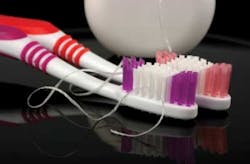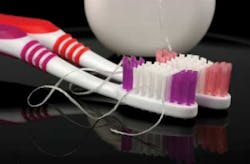It’s time to revisit gingivitis
Gingivitis is a diagnosis, not a health condition
by Heidi Arndt, RDH, BS, and Richard H. Nagelberg, DDS
As dental providers, we know that gingivitis is the reversible precursor to periodontal disease. If it is not controlled, it can progress to full-blown perio disease. It is most commonly caused by inadequate biofilm control, with the remedy being improved home care. The standard of care for gingivitis does not include professional intervention other than a prophy. These facts are so widely accepted that they amount to dental dogma, but are they accurate? Have we, as a profession, been addressing our gingivitis patients properly? Perhaps it is time to revisit our assumptions.
Is gingivitis truly a reversible condition, or is it noncurable but controllable like periodontitis? Periodontal disease is a chronic, noncurable bacterial infection, with the damage to perio tissue being caused by the body’s immuno-inflammatory response to the perio pathogens. When periodontitis patients respond favorably to any treatment we provide, they are healed, not cured. When we stabilize periodontitis, bone resorption ceases, although the damage to the bone that has already occurred does not repair on its own. The bone is gone for good, unless regenerative procedures are undertaken. The soft tissue responds by reductions in pocket depth, swelling, redness, and bleeding. If the patient’s biofilm control efforts are inadequate and they fail to present for perio maintenance appointments every three months, active disease and tissue destruction returns.
Gingivitis is also caused by the body’s response to bacteria, manifesting as redness, swelling, and bleeding, without pocketing or bone loss. Addressing gingivitis by providing prophylaxis, along with improved biofilm control efforts, causes reductions in swelling, redness, and bleeding. Failure to continue effective home care and professional care will return the patient to gingivitis in a short period of time.
So what is the difference between gingivitis and its more serious sequelae, periodontitis? Is it merely one of degree? There are some important differences. Gingivitis can be caused by the body’s response to the early biofilm colonizing bacteria, not the later colonizing perio pathogenic bacteria. The early colonizers are less pathogenic. So is this a matter of degree as well? Another important difference is that periodontitis requires a lifetime of disease management in the form of perio maintenance intervals every three months. Gingivitis is most commonly addressed professionally by twice yearly prophies. Another matter merely of degree?
In what ways are the two diseases similar? Both are bacterial infections with tissue damage being the result of the immuno-inflammatory response. Both respond to biofilm reduction and/or addressing the host response. Both conditions will return if biofilm control is inadequate and patients fail to present for their respective professional visits.
Gingivitis is not really an early, mild form of periodontitis, as is commonly assumed. We know this from several lines of evidence. From a host response perspective, there are important differences in the body’s response during gingivitis and periodontitis. Numerous studies have demonstrated that periodontitis is primarily a B cell and plasma cell response, while gingivitis is primarily a T cell mediated response. From a genetic perspective, we know that progression from gingivitis to periodontitis involves the interplay of inflammatory mediators, DNA expression, and periodontal pathogens. For disease progression to occur, the patient must be genetically susceptible to periodontitis. The inflammatory processes associated with gingivitis act as a switch to turn on the patient’s DNA, which may or may not dictate expression of periodontitis. If the patient is genetically susceptible to periodontal disease, when his or her DNA is ignited by the gingivitis switch, the tissue becomes more susceptible to reinfection by the perio pathogens, which are programmed to take advantage of this situation, potentially leading to periodontitis.
From a clinical perspective, we know that progression to full-blown perio disease does not occur automatically, does not occur in every patient, and does not occur in every site. Gingivitis is not really an early form of periodontitis; it is the gatekeeper to it. The presence of gingivitis is a necessary prelude to periodontitis. This disease progression will occur in some cases, but not in others. Most importantly, a casual approach to gingivitis is inappropriate and may increase the likelihood of developing periodontitis in susceptible individuals.
How we think about and approach our patients who have gingivitis is perhaps among the most important decisions we make as clinicians. The concept that no therapeutic intervention is required to address gingivitis minimizes its importance. Prophylaxis is the standard of care and prophy is defined as a nontherapeutic procedure for the maintenance of a healthy patient. Is a nontherapeutic protocol at six-month intervals appropriate? From an insurance standpoint, the code for prophy — 1110 — establishes a diagnosis of health. From a clinical standpoint, however, the patient has diseased gingiva.
Modifying our philosophy regarding the manner in which we address gingivitis is perhaps in order. It lies somewhere between periodontitis and health, yet there is no treatment protocol that prevents gingivitis patients from falling through the cracks, too often progressing to full-blown periodontal disease.
Gingivitis is a very pervasive disease, affecting 50% to 90% of adults worldwide.1
How often are we giving our patients a diagnosis of gingivitis?
What should we be doing differently for these patients?
If we are not treating our gingivitis patients differently than our healthy and periodontal patients, then modification of our current philosophy of care and treatment protocols is in order for the practice.
The clinical findings of gingivitis as described by the Academy of Periodontology are: pocketing <3 mm, bleeding on probing, with no attachment loss present. How many patients do you see daily who fit these criteria? We may be amazed at the number of patients who fit the gingivitis diagnosis.
The frequency is so large that it is easy to become desensitized and limit recommendations to “Bump up your home care,” or “You need to floss more.” Pausing to consider the reasons why an individual has gingivitis and developing a treatment plan to address the etiology will have enormous benefits for our patients.
So, what would a treatment protocol look like for the gingivitis patient? Here are some recommendations:
- Patient education and motivation is the key to successful management of gingivitis. The patient must understand the gingivitis diagnosis and the importance of managing it. As mentioned earlier, gingivitis is the gatekeeper to periodontal disease. The mismanagement of gingivitis increases the potential for progression to nonreversible periodontitis in susceptible individuals, requiring a lifetime of disease control.
- Frequent dental hygiene appointments. The most conservative professional approach to managing gingivitis is to provide prophylaxis for the patient on a one-to-three-month interval until gingival health is restored.
- Personalize oral hygiene instructions. Review the patient’s risk factors and oral hygiene habits in order to create a home-care regimen that works for them. Let’s face it; not all patients will floss and use a mouthrinse daily. Personalized home care is the key to the long-term success of patient follow-through and oral health. Recommend or provide the tools necessary to enhance each individual patient’s bacterial removal efforts. Utilize the wide variety of items at our disposal including interdental cleaners such as the Proxabrush, rubber tip stimulators, oral irrigators, and tongue cleaners. Recommending a power toothbrush such as the Philips Sonicare to your patients will improve biofilm removal at home. Powered toothbrushes have been proven to remove biofilm and improve gingival health better than manual toothbrushes.
- Incorporate antimicrobial mouth rinses. Antimicrobial mouth rinses should be incorporated into your patients’ home-care regimen. At-home antimicrobials such as chlorhexidine, essential oils, cetylpyridinium chloride (CPC), triclosan, and stannous fluoride have all been proven to support the control of gingivitis by decreasing biofilm growth.2,3,4
- Oral DNA testing. Have you ever had a patient who has exceptional oral hygiene and follows all treatment recommendations, but presents visit after visit with gingivitis? The underlying reasons for this clinical presentation are determined by Oral DNA salivary testing. The Oral DNA test (www.oraldna.com) will help you identify the type of bacteria, the amounts present, and antimicrobial recommendations for eradicating the pathogenic bacteria. The test results then determine the proper treatment protocol. For example, gingivitis patients with high levels of bacteria will benefit from an antimicrobial treatment plan. This may take the form of a thorough prophy, irrigation with 10% povidone iodine (Betadine) or chlorhexidine, and the use of systemic antibiotics such as amoxicillin, metronidazole, or clindamycin. Patients with low bacterial levels require a completely different approach, such as the implementation of a host modulatory treatment plan utilizing 20 mg doxycycline (Periostat). Without the information provided by salivary DNA testing, we don’t know the bacteriological status underlying the gingivitis in patients with excellent home care. Treatment decisions would be an educated guess at best.
Gingivitis is a diagnosis, and should be treated differently than our healthy or periodontal patients. Preventing the progression of gingivitis to periodontitis is the single most important thing we can do for our patients. Thinking of gingivitis as a nonreversible condition and addressing it in a more proactive manner will safeguard the oral and general health of our patients.
Heidi Arndt, RDH, BSDH, is the general manager of Focus Practice Consultants as well as the director of dental hygiene development for American Dental Partners Inc (ADPI). ADPI is a business partner to group dental practices throughout the country. Heidi has 16 years of dental experience. She started her dental career working as a dental assistant and practice manager before going to dental hygiene school. Her dental hygiene experience includes working as a clinical instructor at two dental hygiene schools, a periodontal dental hygienist at Mayo Clinic, and most recently as a dental hygiene mentor and coach to hundreds of dental hygienists across the country. Heidi is an expert at training dynamic teams that deliver high-quality patient care and increased profitability. You can reach Heidi at [email protected].
Richard H. Nagelberg, DDS, has practiced general dentistry in suburban Philadelphia for more than 27 years. He is a speaker, advisory board member, consultant, and key opinion leader for several dental companies and organizations. He lectures extensively on a variety of topics centered on understandingthe impact dental professionals have beyond the oral cavity. Contact him at [email protected].
References
1. Albandar JM, Rams TE. Global epidemiology of periodontal diseases: an overview. Periodontal 2000. 2002;29:7-10.
2. Lorenz K, Bruhn G, Heumann C, Netuschil L, Brecx M, Hoffmann T. Effect of two new chlorhexidine mouthrinses on the development of dental plaque, gingivitis, and discoloration. A randomized, investigator-blind, placebo-controlled, 3-week experimental gingivitis study. J Clin Periodontol. 2006;33:561-567.
3. Cortelli SC, Cortelli JR, Holzhausen M, et al. Essential oils in one-stage full-mouth disinfection: double-blind, randomized clinical trials of long-term clinical, microbial and salivary effects. J Clin Periodontol. 2009;36:333-342.
4. Kozak KM, Gibb R, Dunavent J, White DJ. Efficacy of a high bioavailable cetylpyridinium chloride mouthrinse over a 24-hour period: a plaque imaging study. Am J Dent. 2005;18(Spec No):18A-23A.
5. Barnes CM. The bottom line on toothbrushes. Dimensions of Dental Hygiene; Feb./March 2003;1(1):32-33,35, 37.

